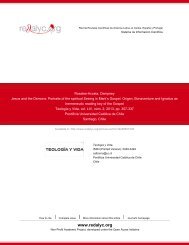A Key Concept in Modern Translation Theory - Redalyc
A Key Concept in Modern Translation Theory - Redalyc
A Key Concept in Modern Translation Theory - Redalyc
Create successful ePaper yourself
Turn your PDF publications into a flip-book with our unique Google optimized e-Paper software.
68 EQUIVALENCE REVISITED: A KEY CONCEPT IN MODERN TRANSLATION THEORY<br />
from other l<strong>in</strong>guistic products because there exists a close l<strong>in</strong>k between ST and<br />
TT: equivalence. This is precisely the po<strong>in</strong>t of departure of TOT: the constitutive<br />
role played by the ST and its contextual factors <strong>in</strong> the fabrication of the translation<br />
<strong>in</strong>to the target language is widely recognized.<br />
3. GROUNDLESS CRITICISM ON LINGUISTICS/TEXT-ORIENTED<br />
THEORIES (TOT)<br />
Unfortunately so far there has been little or almost no contact between<br />
these two trends (COT / TOT) <strong>in</strong> modern translation studies. Their bibliographies<br />
are mutually exclusive. The few occasions <strong>in</strong> which some reference has been<br />
made to the other approach has been <strong>in</strong> order to criticize it on a not very sound<br />
basis. And this has been the case specially when aesthetic-related (COT)<br />
approaches have analyzed the contribution of l<strong>in</strong>guistics to translation theory.<br />
This po<strong>in</strong>t is clearly illustrated <strong>in</strong> the follow<strong>in</strong>g statement by Venuti (1998):<br />
“<strong>Translation</strong> research and translator tra<strong>in</strong><strong>in</strong>g have been impeded by the<br />
prevalence of l<strong>in</strong>guistics-oriented approaches that offer a truncated view of the<br />
empirical data they collect. Because such approaches promote scientific models<br />
for research, they rema<strong>in</strong> reluctant to take <strong>in</strong>to account the social values that<br />
enter <strong>in</strong>to translat<strong>in</strong>g a well as the study of it. Research then becomes scientistic,<br />
claim<strong>in</strong>g to be objective or value-free, ignor<strong>in</strong>g the fact that translation, like any<br />
other cultural practice, entails the creative reproduction of values. As a result,<br />
translation studies get reduced to the formulation of general theories and the<br />
description of textual features and strategies. These l<strong>in</strong>es of research are not<br />
only limited <strong>in</strong> their explanatory power, but directed primarily to other academic<br />
specialists <strong>in</strong> l<strong>in</strong>guistics, <strong>in</strong>stead of translators or readers of translators or even<br />
specialists <strong>in</strong> other humanistic discipl<strong>in</strong>es” (p.1).<br />
Even though we have already discussed this aspect elsewhere (Bolaños<br />
1997 / 2001), we would like to review once aga<strong>in</strong> the ma<strong>in</strong> po<strong>in</strong>ts of our<br />
counterargument. First of all, it is not clear what Venuti means by “the prevalence<br />
of l<strong>in</strong>guistics-oriented approaches that offer a truncated view of the empirical<br />
data they collect”. It is evident that l<strong>in</strong>guistics as such has not shown much<br />
<strong>in</strong>terest <strong>in</strong> the problematic of translation. This is aptly highlighted <strong>in</strong> the follow<strong>in</strong>g<br />
quotations from three different authors which cover a three-decade period: G.<br />
Moun<strong>in</strong>, J. Albrecht, and M. Doherty.<br />
“Cosa todavía más s<strong>in</strong>gular referente al estudio científico de la actividad<br />
traductora: mientras que todo tratado empírico de filosofía debe <strong>in</strong>cluir una teoría
















